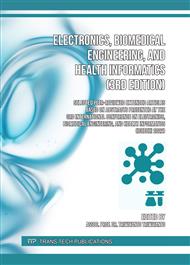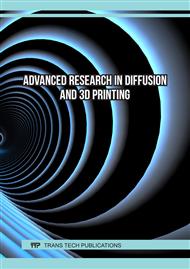[1]
M. S. Alsoufi and A. E. Elsayed, "Surface Roughness Quality and Dimensional Accuracy—A Comprehensive Analysis of 100% Infill Printed Parts Fabricated by a Personal/Desktop Cost-Effective FDM 3D Printer," Mater. Sci. Appl., vol. 09, no. 01, p.11–40, 2018.
DOI: 10.4236/msa.2018.91002
Google Scholar
[2]
C. Gardin, L. Ferroni, C. Latremouille, J. C. Chachques, D. Mitrečić, and B. Zavan, Recent Applications of Three Dimensional Printing in Cardiovascular Medicine, vol. 9, no. 3. 2020.
DOI: 10.3390/cells9030742
Google Scholar
[3]
A. A. Giannopoulos and T. Pietila, "Post-processing of DICOM Images," 3D Print. Med., p.23–34, 2017.
DOI: 10.1007/978-3-319-61924-8_3
Google Scholar
[4]
S. A. Azer and S. Azer, "3D Anatomy Models and Impact on Learning: A Review of the Quality of the Literature," Heal. Prof. Educ., vol. 2, no. 2, p.80–98, 2016.
DOI: 10.1016/j.hpe.2016.05.002
Google Scholar
[5]
C. F. Smith, N. Tollemache, D. Covill, and M. Johnston, "Take away body parts! An investigation into the use of 3D-printed anatomical models in undergraduate anatomy education," Anat. Sci. Educ., vol. 11, no. 1, p.44–53, 2018.
DOI: 10.1002/ase.1718
Google Scholar
[6]
D. K. Mills, K. Tappa, U. Jammalamadaka, P. A. S. Mills, J. S. Alexander, and J. A. Weisman, "Medical Applications for 3D Printing," Adv. Manuf. Process. Mater. Struct., no. February, p.163–186, 2018.
DOI: 10.1201/b22020-8
Google Scholar
[7]
A. A. Giannopoulos, D. Mitsouras, S. J. Yoo, P. P. Liu, Y. S. Chatzizisis, and F. J. Rybicki, "Applications of 3D printing in cardiovascular diseases," Nat. Rev. Cardiol., vol. 13, no. 12, p.701–718, 2016.
DOI: 10.1038/nrcardio.2016.170
Google Scholar
[8]
K. H. C. Li et al., "The role of 3D printing in anatomy education and surgical training: A narrative review," MedEdPublish, vol. 6, no. 2, 2017.
DOI: 10.15694/mep.2017.000092
Google Scholar
[9]
J. Garcia, Z. L. Yang, R. Mongrain, R. L. Leask, and K. Lachapelle, "3D printing materials and their use in medical education: A review of current technology and trends for the future," BMJ Simul. Technol. Enhanc. Learn., vol. 4, no. 1, p.27–40, 2018.
DOI: 10.1136/bmjstel-2017-000234
Google Scholar
[10]
A.-M. Wu et al., "The addition of 3D printed models to enhance the teaching and learning of bone spatial anatomy and fractures for undergraduate students: a randomized controlled study," Ann. Transl. Med., vol. 6, no. 20, p.403–403, 2018.
DOI: 10.21037/atm.2018.09.59
Google Scholar
[11]
L. M. Meier, M. Meineri, J. Qua Hiansen, and E. M. Horlick, "Structural and congenital heart disease interventions: The role of three-dimensional printing," Netherlands Hear. J., vol. 25, no. 2, p.65–75, 2017.
DOI: 10.1007/s12471-016-0942-3
Google Scholar
[12]
P. P. Ratna Gharini, Herianto, N. Arfian, F. Bayu Satria, and N. Amin, "3 Dimensional Printing in Cardiology: Innovation for Modern Education and Clinical Implementation," ACI (Acta Cardiol. Indones., vol. 4, no. 2, p.103–109, 2018.
DOI: 10.22146/aci.40855
Google Scholar
[13]
R. Chotikunnan, P. Chotikunnan, T. Puttasakul, M. Sangworasil, T. Matsuura, and N. Tongpance, "A Novel Technique for 3D Printer to Create Organ 3D Model from DICOM File," RSU Int. Res. Conf., no. April, p.176–183, 2017.
DOI: 10.1109/bmeicon.2017.8229165
Google Scholar
[14]
G. Gómez-Ciriza, T. Gómez-Cía, J. A. Rivas-González, M. N. Velasco Forte, and I. Valverde, "Affordable Three-Dimensional Printed Heart Models," Front. Cardiovasc. Med., vol. 8, no. June, p.3–10, 2021.
DOI: 10.3389/fcvm.2021.642011
Google Scholar
[15]
Z. Sun, I. Lau, Y. H. Wong, and C. H. Yeong, "Personalized three-dimensional printed models in congenital heart disease," J. Clin. Med., vol. 8, no. 4, p.1–17, 2019.
DOI: 10.3390/jcm8040522
Google Scholar
[16]
I. Brewis and J. A. Mclaughlin, "Improved Visualisation of Patient-Specific Heart Structure Using Three-Dimensional Printing Coupled with Image-Processing Techniques Inspired by Astrophysical Methods," J. Med. Imaging Heal. Informatics, vol. 9, no. 2, p.267–273, 2019.
DOI: 10.1166/jmihi.2019.2644
Google Scholar
[17]
X. Hou, D. Yang, D. Li, M. Liu, Y. Zhou, and M. Shi, "A new simple brain segmentation method for extracerebral intracranial tumors," PLoS One, vol. 15, no. 4, p.1–11, 2020.
DOI: 10.1371/journal.pone.0230754
Google Scholar
[18]
Y. Wang, H. Wang, K. Shen, J. Chang, and J. Cui, "Brain CT image segmentation based on 3D slicer," J. Complex. Heal. Sci., vol. 3, no. 1, p.34–42, 2020, doi: 10.21595/chs.2020. 21263.
DOI: 10.21595/chs.2020.21263
Google Scholar
[19]
N. Jegou et al., "Organs-at-risk contouring on head CT for RT planning using 3D slicer-A preliminary study," Proc. - 2019 IEEE 19th Int. Conf. Bioinforma. Bioeng. BIBE 2019, p.503–506, 2019.
DOI: 10.1109/BIBE.2019.00097
Google Scholar
[20]
F. C. F. Dionísio et al., "Manual and semiautomatic segmentation of bone sarcomas on mri have high similarity," Brazilian J. Med. Biol. Res., vol. 53, no. 2, p.1–10, 2020.
DOI: 10.1590/1414-431x20198962
Google Scholar
[21]
D. Argüello, H. G. Sánchez Acevedo, and O. A. González-Estrada, "Comparison of segmentation tools for structural analysis of bone tissues by finite elements," J. Phys. Conf. Ser., vol. 1386, no. 1, 2019.
DOI: 10.1088/1742-6596/1386/1/012113
Google Scholar
[22]
C. Pinter et al., "3D Slicer Documentation," 2021.
Google Scholar
[23]
D. I. Nikitichev et al., "Patient-Specific 3D Printed Models for Education, Research and Surgical Simulation," 3D Print., 2018.
DOI: 10.5772/intechopen.79667
Google Scholar
[24]
T. M. Bücking, E. R. Hill, J. L. Robertson, E. Maneas, A. A. Plumb, and D. I. Nikitichev, "From medical imaging data to 3D printed anatomical models," PLoS One, vol. 12, no. 5, p.1–10, 2017.
DOI: 10.1371/journal.pone.0178540
Google Scholar
[25]
K. Qiu, G. Haghiashtiani, and M. C. McAlpine, "3D Printed Organ Models for Surgical Applications," Annu. Rev. Anal. Chem., vol. 11, no. June 2018, p.287–306, 2018.
DOI: 10.1146/annurev-anchem-061417-125935
Google Scholar
[26]
J. H. Panjaitan, M. Tampubolon, F. Sihombing, and J. Simanjuntak, "Pengaruh Kecepatan, Temperatur dan Infill Terhadap Kualitas dan Kekasaran Kotak Relay Lampu Sign Sepedamotor Hasil dari 3D Printing," Sprocket J. Mech. Eng., vol. 2, no. 2, p.87–99, 2021.
DOI: 10.36655/sproket.v2i2.530
Google Scholar
[27]
R. Polak, F. Sedlacek, and K. Raz, "Determination of fdmprinter settings with regard to geometrical accuracy," Ann. DAAAM Proc. Int. DAAAM Symp., no. August 2018, p.561–566, 2017.
DOI: 10.2507/28th.daaam.proceedings.079
Google Scholar
[28]
N. Aliheidari, R. Tripuraneni, C. Hohimer, J. Christ, A. Ameli, and S. Nadimpalli, "The impact of nozzle and bed temperatures on the fracture resistance of FDM printed materials," Behav. Mech. Multifunct. Mater. Compos. 2017, vol. 10165, p.1016512, 2017.
DOI: 10.1117/12.2260105
Google Scholar
[29]
M. Odeh et al., "Methods for verification of 3D printed anatomic model accuracy using cardiac models as an example," 3D Print. Med., vol. 5, no. 1, p.1–12, 2019.
DOI: 10.1186/s41205-019-0043-1
Google Scholar
[30]
T. Asmaria, D. Sajuti, and K. Ain, "3D printed PLA of gallbladder for virtual surgery planning," AIP Conf. Proc., vol. 2232, no. April, 2020.
DOI: 10.1063/5.0001732
Google Scholar
[31]
P. Mohazzab, "Archimedes' Principle Revisited," J. Appl. Math. Phys., vol. 05, no. 04, p.836–843, 2017.
DOI: 10.4236/jamp.2017.54073
Google Scholar
[32]
M. Bertolini, M. Rossoni, and G. Colombo, "Operative workflow from ct to 3d printing of the heart: Opportunities and challenges," Bioengineering, vol. 8, no. 10, 2021.
DOI: 10.3390/bioengineering8100130
Google Scholar
[33]
S.-J. Yoo et al., "3D printing in medicine of congenital heart diseases," 3D Print. Med., vol. 2, no. 1, 2016.
DOI: 10.1186/s41205-016-0004-x
Google Scholar
[34]
L. Brouwers, A. Teutelink, F. A. J. B. van Tilborg, M. A. C. de Jongh, K. W. W. Lansink, and M. Bemelman, "Validation study of 3D-printed anatomical models using 2 PLA printers for preoperative planning in trauma surgery, a human cadaver study," Eur. J. Trauma Emerg. Surg., vol. 45, no. 6, p.1013–1020, 2019.
DOI: 10.1007/s00068-018-0970-3
Google Scholar



